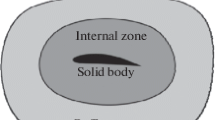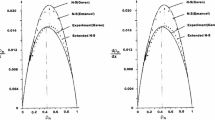Abstract
A new technique for the numerical analysis of aerodynamic noise generation is developed. The approach involves first solving for the time-dependent incompressible flow for the given geometry. A “hydrodynamic” density correction to the constant incompressible density is then calculated from knowledge of the incompressible pressure fluctuations. The compressible flow solution is finally obtained by considering perturbations about the “corrected” incompressible flow. This fully nonlinear technique, which is tailored to extract the relevant acoustic fluctuations, appears to be an efficient approach to the numerical analysis of aerodynamic noise generation, particularly in viscous flows. Applications of this technique to some classical acoustic problems of interest, including some with moderately high subsonic Mach numbers, are presented to validate the approach. The technique is then applied to a fully viscous problem where sound is generated by the flow dynamics.
Similar content being viewed by others
References
Lighthill, M.J.: On Sound Generated Aerodynamically: 1. General Theory, Proc. Roy. Soc. London Ser. A, vol. 211, pp. 564–587, 1952.
Hardin, J.C.: Introduction to Computational Aeroacoustics in Aerodynamics, AIAA Professional Studies Series Short Course, Reno, NV, Jan. 10–11, 1992.
Batchelor, G.K.: An Introduction to Fluid Dynamics, Cambridge University Press, Cambridge, 1967.
Geer, J.F., and Pope, D.S.: A Multiple Scales Approach to Sound Generation by Vibrating Bodies, Computational Aeroacoustics, pp. 69–84, Springer-Verlag, New York, 1993.
MacCormack, R.W.: A Numerical Method for Solving the Equations of Compressible Viscous Flow, AIAA Paper No. 81-0110, 1981.
Block, P.J.W.: Noise Response of Cavities of Varying Dimensions at Subsonic Speeds, NASA TND-8351, 1976.
Kreiss, H.O.: Initial Boundary Value Problems for Hyperbolic Systems, Comm. Pure Appl. Math, vol. 23, pp. 277–298, 1970.
Thompson, K.W.: Time-Dependent Boundary Conditions for Hyperbolic Systems, J. Comput. Phys., vol. 68, pp. 1–24, 1987.
Watson, W.R.: A Time Domain Numerical Theory for Studying Steady-State Acoustic Disturbances in Flow, Ph.D. Thesis, George Washington University, 1991.
Author information
Authors and Affiliations
Additional information
Communicated by M.Y. Hussaini
Rights and permissions
About this article
Cite this article
Hardin, J.C., Pope, D.S. An acoustic/viscous splitting technique for computational aeroacoustics. Theoret. Comput. Fluid Dynamics 6, 323–340 (1994). https://doi.org/10.1007/BF00311844
Received:
Accepted:
Issue Date:
DOI: https://doi.org/10.1007/BF00311844




